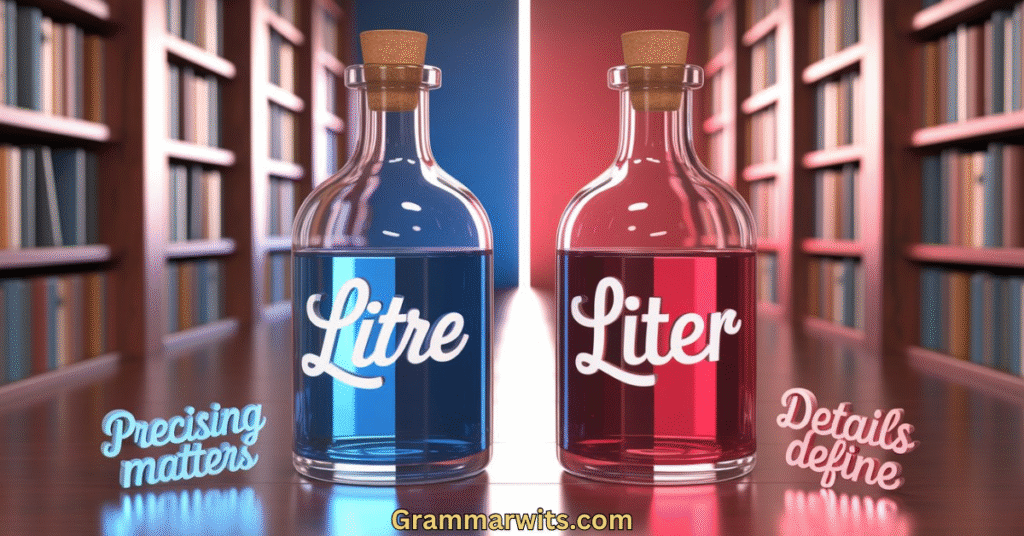Litre and liter both refer to a unit of volume in the metric system, equal to 1,000 milliliters or about 33.8 fluid ounces. Used globally to measure liquids and some bulk solids, these terms are identical in meaning but differ in spelling depending on the region. “Litre” is the standard in British English-speaking countries, while “liter” is the preferred form in American English. Despite the spelling shift, their function and value remain universally consistent.
English is full of regional quirks, and nothing highlights that better than the subtle yet persistent divide between “litre” and “liter.” This tiny difference in spelling carries the weight of history, national identity, and linguistic evolution. If you’ve ever switched between American and British content or prepared global documents, you’ve likely stumbled across this inconsistency—one that can subtly shape how polished or region-appropriate your writing feels.
Understanding litre and liter isn’t just about grammar—it’s about using language intentionally in international communication, academic writing, and even marketing. Whether you’re writing a scientific paper, localizing content, or simply labeling a product, knowing when to use each form of the word adds credibility and clarity.
The Core Difference Explained
Litre and Liter measure identical volumes – exactly 1000 milliliters or 33.814 fluid ounces. The distinction comes down to geographic regional language preferences.
Litre follows British spelling conventions. You’ll see this spelling throughout the United Kingdom, Canada, Australia, and most Commonwealth nations. The “re” ending aligns with French spelling traditions that influenced early British English.
Liter represents American spelling. Noah Webster, the famous American lexicographer, championed simplified spelling reforms in the early 1800s. He believed American English should shed unnecessary letters and embrace phonetic clarity.
| Spelling | Region | Population Using |
|---|---|---|
| Litre | British/Commonwealth | ~400 million |
| Liter | American | ~330 million |
Both spellings appear in the metric system as the standard unit of volume. Whether you’re measuring paint, tracking hydration, or working in a science lab, the actual volume measurement remains constant.
Geographic Usage Breakdown
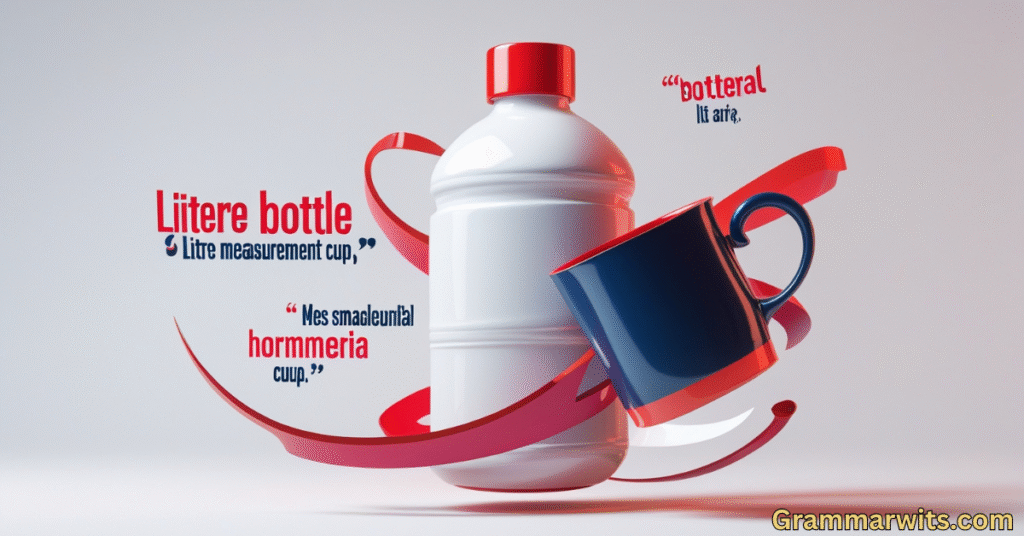
Countries That Use “Litre”
The British spelling “litre” dominates across numerous English-speaking territories. Understanding where each spelling thrives helps you communicate effectively with your target audience.
Primary “Litre” Regions:
- United Kingdom (66 million speakers)
- Canada (38 million speakers)
- Australia (25 million speakers)
- New Zealand (5 million speakers)
- South Africa (60 million total, 5 million native English speakers)
European Union countries teaching English as a second language typically adopt British English conventions. This includes the “litre” spelling in educational materials and official documentation.
India presents an interesting case. With over 125 million English speakers, India officially uses British spelling due to colonial history. However, American influence through technology and media creates some inconsistency.
Countries That Use “Liter”
American English spelling dominates in fewer countries but reaches massive populations through cultural export and international business.
Primary “Liter” Regions:
- United States (330 million speakers)
- Philippines (92 million total, 14 million fluent English speakers)
- Liberia (5 million speakers)
The American spelling also appears frequently in:
- International scientific writing
- Global technology companies
- Multinational context business communications
- Medical research publications
American cultural influence through movies, music, and social media spreads the “liter” spelling worldwide. Many young people in British English countries encounter both spellings daily.
Context-Specific Rules
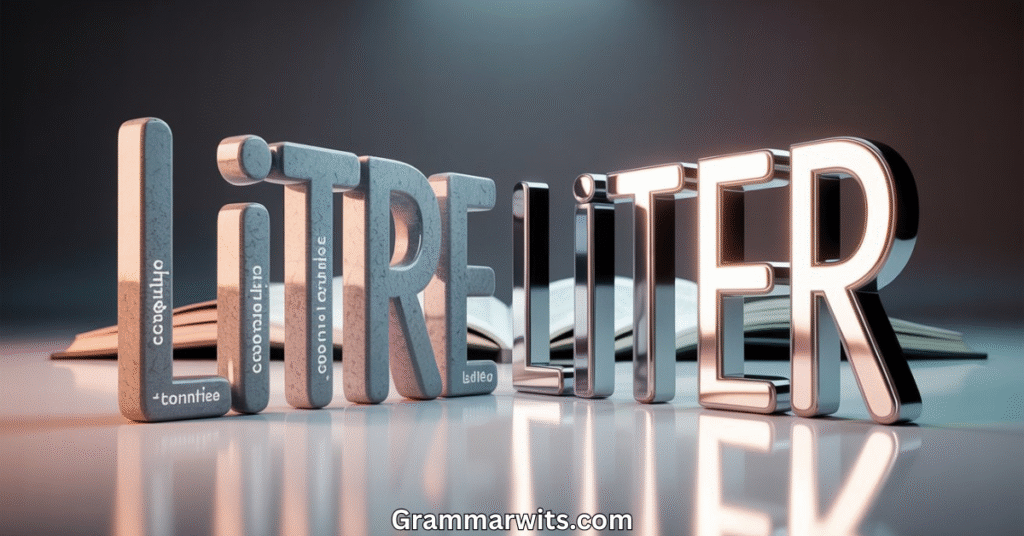
Academic Writing Standards
Academic writing demands precision in spelling consistency. Your choice between Litre and Liter should align with established style guide requirements.
APA Style (American Psychological Association) mandates American spelling throughout academic papers. This means “liter” for psychology, education, and social science research.
MLA Style (Modern Language Association) also requires American English conventions. Literature and humanities papers should use “liter” consistently.
Chicago Style offers flexibility. The Chicago Manual of Style accommodates both British English and American English depending on your target audience and publication venue.
International journals present mixed requirements. Scientific writing often leans toward American spelling due to the dominance of U.S. research institutions. However, European journals may prefer British spelling.
Business Communications Strategy
Smart businesses adapt their spelling differences strategy based on market focus. Multinational context communications require careful consideration of regional preferences.
Coca-Cola uses “litre” on packaging sold in British English markets but “liter” for American consumers. This localization builds stronger connections with regional audiences.
Unilever, the British-Dutch multinational, consistently uses “litre” across all markets to maintain British English brand identity. Their language standardization reinforces corporate origins.
Recipe book publishers face unique challenges. American cookbooks use “liter” measurements, while British publications stick with “litre.” International cookbooks often include conversion charts showing both spellings.
Real-World Examples in Action
Understanding Litre and Liter through practical examples clarifies when each spelling fits best. These scenarios demonstrate proper usage across different contexts.
Scientific Context:
- American chemistry textbook: “Add 2 liters of distilled water to the solution.”
- British laboratory manual: “Measure 500ml using a 1-litre beaker.”
Commercial Context:
- U.S. gas station: “Premium gasoline: $3.45 per liter“
- Canadian fuel station: “Regular petrol: $1.32 per litre“
Medical Context:
- American hospital chart: “Patient requires 3 liters IV fluid daily”
- NHS documentation: “Recommended daily fluid intake: 2 litres“
Automotive Context:
- American car manual: “Engine oil capacity: 4.2 liters“
- British vehicle handbook: “Fuel tank capacity: 45 litres“
Paint manufacturers demonstrate regional adaptation perfectly. Sherwin-Williams labels American products in “liters” while their international subsidiaries use “litres” for overseas markets.
Etymology Deep Dive
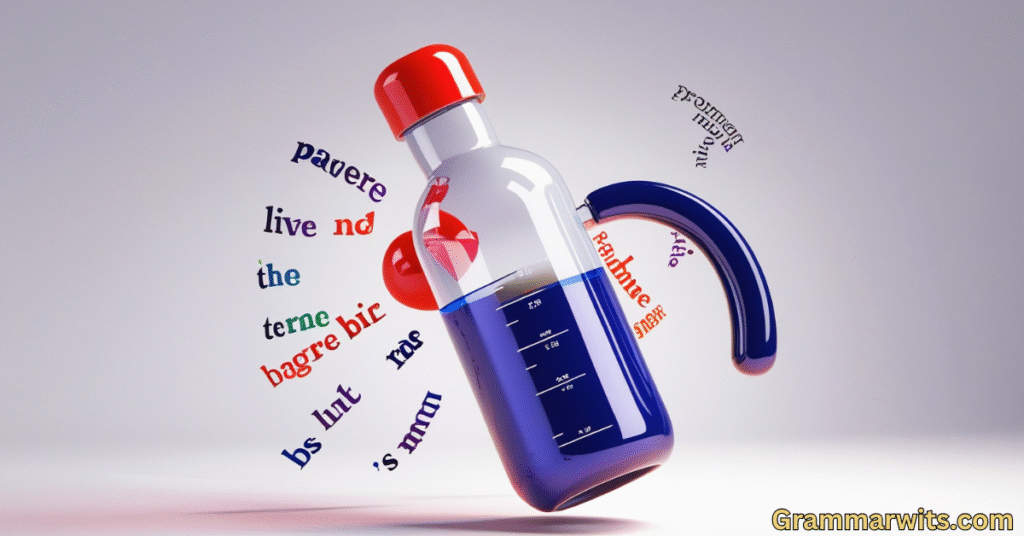
The fascinating history of Litre and Liter reveals how language evolution shaped modern spelling differences. Both words trace back through French spelling to ancient origins.
Medieval Latin “litra” provided the foundation for modern usage. This term descended from Greek litra, meaning “pound” or unit of weight. The connection to Libra (the zodiac sign representing balance) reinforces measurement associations.
France formalized “litre” in 1795 during metric system development. Revolutionary France sought standardized measurement units to replace chaotic regional systems. The French spelling spread throughout Europe and British colonies.
Noah Webster targeted “litre” during his American English reforms. His 1828 dictionary promoted “liter” alongside other simplified spelling changes like “color” (from “colour”) and “center” (from “centre”).
Webster believed American independence required linguistic independence. His reforms aimed to:
- Eliminate silent letters
- Simplify complex spellings
- Create phonetic consistency
- Establish American cultural identity
The spelling variation between Litre and Liter exemplifies broader patterns in English spelling rules. American preferences generally favor shorter, more phonetic forms while British English preserves historical spellings.
Common Mistakes to Avoid
Even experienced writers stumble when navigating Litre and Liter usage. These frequent errors can undermine your credibility and confuse readers.
Mixing Spellings Within Documents: Inconsistency destroys professional appearance. Choose “litre” or “liter” at the start and maintain that choice throughout your entire document.
Wrong Spelling for Target Audience: American readers expect “liter” in professional contexts. Using “litre” in U.S. business communications signals unfamiliarity with local conventions.
Ignoring Publication Requirements: Academic writing and scientific writing often specify required spellings. Always check style guide requirements before finalizing your work.
Assuming One Version is “More Correct”: Both British spelling and American spelling represent valid, standardized forms. Neither version is inherently superior or more accurate.
Forgetting Company Standards: Many organizations establish internal spelling consistency policies. Check existing company materials before choosing between Litre and Liter.
Quick Decision Framework
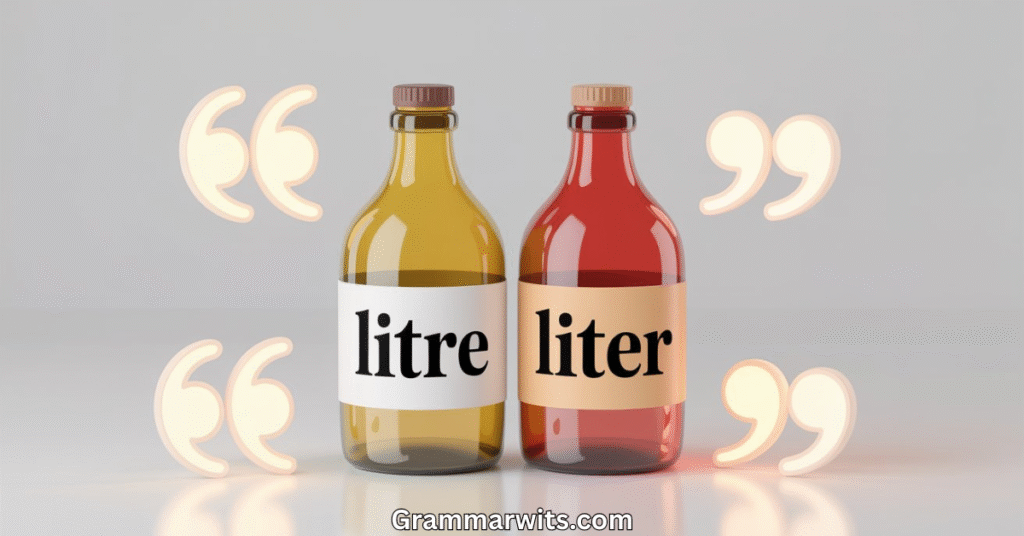
This simple framework helps you choose between Litre and Liter in any situation. Follow these steps for confident decision-making.
Step 1: Identify Your Primary Audience
- American readers → Use “liter”
- British/Commonwealth readers → Use “litre”
- Multinational context → Research company standards
2: Check Publication Requirements
- APA style → “liter”
- MLA style → “liter”
- Chicago style → Match target audience
- International journals → Check submission guidelines
3: Consider Industry Norms
- Scientific writing → Often prefers “liter”
- Medical research → Usually “liter”
- European publications → Typically “litre”
4: Maintain Consistency Whatever you choose, stick with it throughout your entire document, presentation, or communication series.
Advanced Usage Considerations
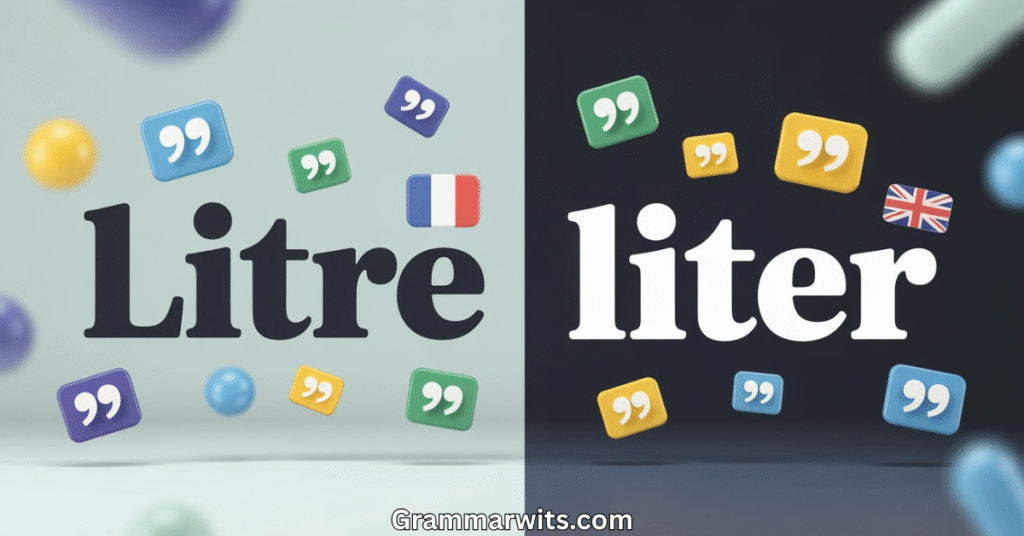
Professional writers must navigate subtle situations where Litre and Liter choice impacts reader perception and document effectiveness.
International Business Contracts: Legal documents require spelling consistency to avoid ambiguity. Many international contracts specify which regional language conventions apply throughout the agreement.
Technical Documentation: Measurement units in user manuals must match the target market’s expectations. Software localization teams carefully adapt volume measurement terminology for each region.
Academic Publishing: Researchers submitting to international journals should research editor preferences. Some publications accept both spellings but require consistency within individual papers.
Brand Localization: Multinational context companies often maintain separate style guides for different markets. Language standardization teams ensure appropriate spelling differences across regions.
Conclusion
Litre and Liter represent identical volume measurements with different regional spellings. British English uses “litre” while American English prefers “liter.” Both versions measure exactly 1000 milliliters and serve the same function in the metric system.
Success comes from understanding your audience and maintaining spelling consistency. Academic writing typically follows American spelling conventions, while multinational context communications should match regional preferences.
The etymology reveals how French spelling influenced British English while Noah Webster’s reforms shaped American English. These spelling differences reflect broader patterns in language evolution and cultural identity.
Master both spellings. Know when each fits best. Your readers will appreciate the attention to detail, and your writing will demonstrate true international awareness.
Frequently Asked Questions
Is “litre” or “liter” the correct spelling? Both spellings are completely correct. “Litre” follows British English conventions used in the UK, Canada, and Australia. “Liter” represents American English spelling used in the United States. Choose based on your target audience’s regional preferences.
Can I use both spellings interchangeably in the same document? No, never mix Litre and Liter within the same document. Spelling consistency is crucial for professional credibility. Pick one spelling at the beginning and maintain it throughout your entire text, presentation, or communication series.
Which spelling do international scientific journals prefer? Most international scientific writing publications prefer “liter” following American English conventions. U.S. research institutions dominate global scientific publishing, establishing “liter” as the standard. However, always check specific journal submission guidelines before finalizing your manuscript.
What about Canada – do they use “litre” or “liter”? Canada officially uses “litre” despite significant American cultural influence. Canadian government documents, education materials, and official publications consistently use British spelling. This maintains Canada’s connection to Commonwealth language standardization while distinguishing Canadian identity from American neighbors.
Should my company pick one spelling globally for all materials? Yes, establish consistent spelling differences policies across all company communications. Many successful multinational context businesses choose one spelling for global brand consistency. However, some companies localize spellings for specific regional markets. Create clear internal guidelines and train all team members on your chosen standard.

Alizy Smith is a passionate language enthusiast and the admin of Grammar Wits. With a love for wordplay, grammar quirks, and witty expressions, she’s dedicated to making language learning fun and accessible. From grammar tips to pun-filled laughs, Alizy ensures every piece of content entertains while educating — turning tricky rules into easy, enjoyable reads.
